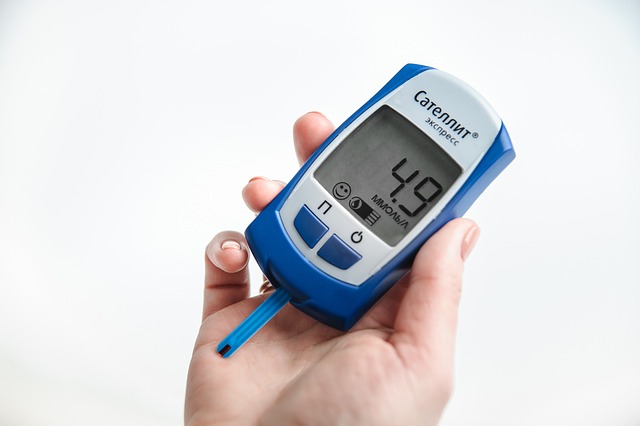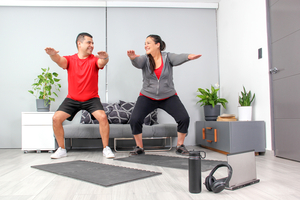In this article:
- Changes in body weight are only one way to measure progress in a health journey. There are times when it is not completely accurate.
- Using a tape measure on your body, checking body fat, and comparing old and current photos are other ways to track progress.
- You can also note changes in fitness, diet, and lifestyle as indicators that you are living healthier.
- Checking in regularly with your healthcare provider, and testing key measures of health can help you see progress.
- Lark can help you make healthy changes and lose weight.
Losing extra pounds can make a dramatic difference in your health risk, but there are other ways to measure progress. While it’s good to keep checking in with your scale to stay accountable, there are times when the scale may not be the best indicator of how you are doing. Here is why the scale shouldn’t be the only thing you focus on, and following are 10 additional ways to see how far you have come on your weight loss and health journey.
Why the Scale Can Be Misleading
If your goal is to lose weight, isn’t it simple? A lower number on the scale is good. A higher number is bad. But that’s not always the case. Sometimes, the scale doesn’t give the whole picture. For example:
- Your weight decreases if you are dehydrated, even if you haven’t lost body fat.
- Your weight can increase if you gain muscle, which is healthy weight.
- Your weight can increase if you are retaining water, even if you haven’t gained body fat.
Your weight can be unpredictable for any number of reasons, such as changes in sleep patterns, excess stress, or daily fluctuations. That’s why other ways to track progress can be helpful.
Ways to Measure Progress without a Scale
1. Use a tape measure.
Muscle is denser than fat. When you lose body fat but work out a lot, you can gain muscle mass and overall weight can increase. In that case, tracking monthly body measurements can help you see progress. Your body may be shrinking, even as weight increases, if you are gaining muscle and losing fat.
These are some common places to measure.
- Waist, around the belly button
- Hips
- Upper arm circumference
- Thighs
Keep the tape measure loose as you measure, and mark the numbers down in a notebook or in your phone.
2. Check body fat.
For health, the underlying goal is to decrease body fat. Even if the scale does not go down, a decrease in excess body fat can be a good sign. Many scales have body fat analyzers, or you can ask your doctor, a trainer at a gym, or another healthcare professional to help you measure it. If you get a pair of body fat calipers, you can follow the included directions to measure yourself, though you may need a buddy to help.
3. Take some selfies.
It’s not always fun to take pictures of yourself when you feel like you’re in your “before” body, but it’s a good way to get a baseline. You can take a weekly photo in the same clothes and pose, or wait for a few weeks between photos. After a while, if you keep making healthy changes, you’ll start to see positive changes in the photos regardless of what the scale says.
4. Try on old clothes.
As your body shrinks, your clothes will fit differently. Clothes that fit well at the beginning of your health journey will become loose. Clothes that may have fit you years ago, but got too small, may fit again. Keep trying on old clothes to stay motivated to keep up the good changes.
5. Log your meals.
When you log your meals, you can see what you are eating and also stay accountable. Another benefit is that you can look back and see the changes.
It’s a good sign for your health when you see changes such as the following.
- More nutritious foods, such as vegetables, whole grains, nuts, fish, and plant-based proteins.
- Fewer less-healthy foods, such as processed foods, fatty meat, sugar-sweetened foods and beverages, and refined grains.
- Smaller portions of high-calorie foods.
When you make changes like this, your weight is sure to decrease, even if the scale is a bit slow to show it. When you log your meals and snacks with Lark, you can get coaching on where you can make improvements the next time.
6. Log your workouts.
Logging your physical activity is another way to see progress. You can check whether you are increasing the amount of activity you get, such as in terms of minutes or number of sessions per week. Lark lets you log workouts and get coaching on them. As Lark learns your habits, you can set new activity goals and get reminders to stay motivated and accountable.
7. Time a mile
Timing a mile is a good way to see if you are more fit, even if the scale has not budged. Or, you can challenge yourself with any fitness test of your choice, such as completing a 5k walk or seeing how many sit-ups you can do in a minute. Write down your score in a notebook and see how it improves time after time.
8. See your doctor.
Ultimately, the goal is to be healthier. If the scale isn’t dropping, but you are following your healthy lifestyle, your health indicators may show improvements. You might want to ask your healthcare provider to check your blood pressure, cholesterol, or blood sugar levels if they were out of range before. It’s possible they are improving.
9. Monitor your lifestyle.
If you’ve been making healthy changes to your food and exercise, it’s possible you’ve been making healthy choices in other areas of your life. You might, for example, be getting more sleep. When you use Lark, you can track your sleep and see whether it is increasing.
10. Look within yourself.
Are you feeling better? Do you have more energy? Do you feel stronger or more confident? Are you able to handle stress better? All of these are signs that you are making good decisions, even if the scale is not cooperating.
Lark can help you through your weight loss and health journey with coaching, logging, and tracking. You may be eligible for Lark and one or more connected devices at no cost to you through your health insurance company. Click here to check!











.webp)






